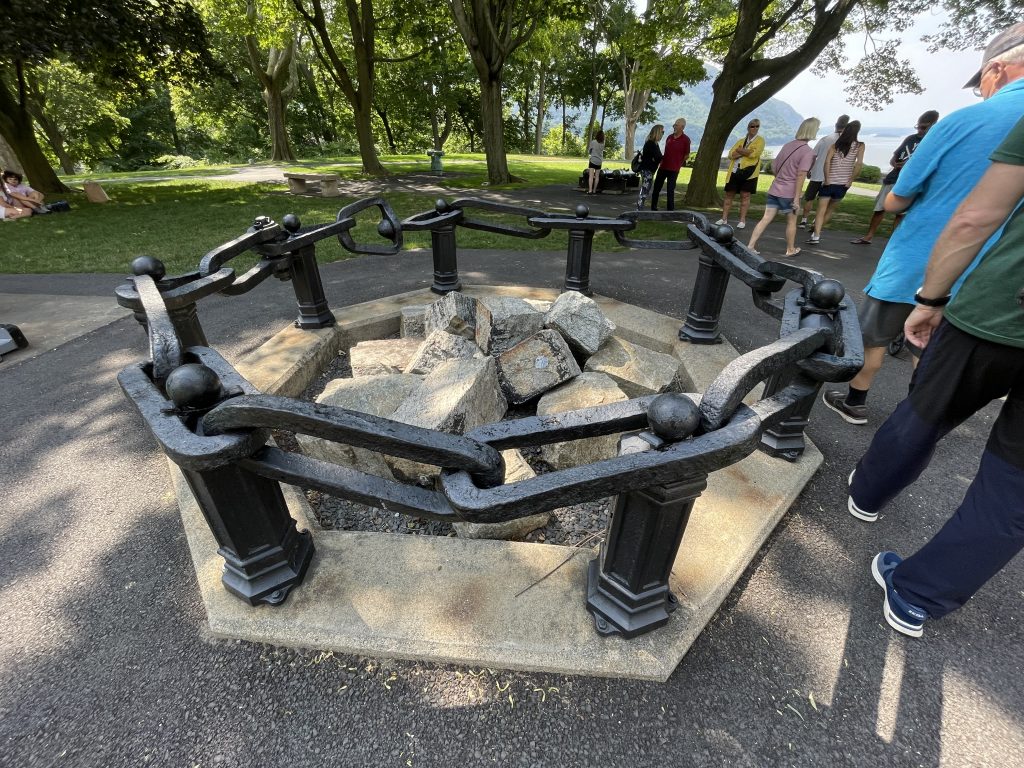On our travels up the Hudson River we stopped in to the United States Military Academy, commonly known as West Point. Though the West Point Museum was closed, the Visitors Center was open and had a detailed exhibit on the life of a student progressing through their four years at the academy.
We also took a bus tour that brought us on campus. Afterwards, we got a background check done so we could get a pass to allow us to drive onto the campus and see the historic cemetery. (And yes, it was a little nerve-wracking approaching the security checkpoint in our big white van.)


Located in West Point, N.Y., the spot was originally established as a fort in 1778 due to its strategic high location over the Hudson River, 50 miles north of New York City.
During the American Revolution, a huge chain was strung across the river just under the water, in hopes it would ensnare British ships en route from New York City.
It was also here that Benedict Arnold committed his failed famous act of treason, taking a bribe from the British so that they could capture West Point.
West Point is the oldest of the five American service academies.
Alexander Hamilton laid out the plans for the military academy, and Thomas Jefferson put the plans in motion in 1801. The first class commenced on July 4, 1802.
Candidates for admission must receive a nomination from a member of Congress, the President, or the Vice-President. Competition is fierce, with just 11% of applicants accepted. Candidates to the academy must be between 17 and 23 years old, unmarried, and with no legal obligation to support a child; they must also pass a physical exam and Fitness Assessment.

Tuition is paid for by the US Government in exchange for an active-duty service obligation upon graduation (five years plus three years in the Army reserves.
Our guide explained that cadets (students) who don’t finish are expected to reimburse the government for their costs, which can be well over $100k depending upon how far the student got in their education. About 1,300 cadets enter the academy each July, but only 1,000 make it through to graduation. Cadets receive a four-year Bachelor of Science degree in one of 45 majors and a commission as a second lieutenant in the United States Army.

I had no idea how prestigious graduation from West Point is, but after the exhibit and tour I could see how anyone would be very proud to be a graduate. The cadet’s experience over their four years is focused on development in the four pillars of academics, character, physical, and military. All cadets are required to participate in a sport, and must pass the Army Physical Fitness Test twice per year and the Indoor Obstacle Course once a year.
Famous graduates include U.S. Presidents Dwight D. Eisenhower and Ulysses S. Grant; Confederate President Jefferson Davis; Confederate general Robert E. Lee; American poet Edgar Allen Poe; U.S. general George Patton; presidents of Costa Rica, Nicaragua, and the Philippines; and 76 Medal of Honor recipients. [source: Wikipedia]

The first black cadet was admitted in 1870 (now representing about 13% of any given class), but it took more than 100 years to admit females, which represent about 20% of classes today.
The “Don’t Ask, Don’t Tell” policy (how exactly did that work with the cadet honor code??) was lifted in 2011, allowing openly gay cadets to enter the academy, with the first gay-straight alliance group formed in 2012.








When Ed and I visited the Shirley Plantation on the James River in VA, we learned of its history as a hospital during the Civil War. Most remarkable, if it’s still being done, is that on a high bluff overlooking the lawn between the home and river, a soldier dressed in a Union uniform plays Taps every dusk. Somewhere later, I saw photos of that lawn covered with hundreds of wounded soldiers, for whom Taps was played to bring them peace. It was the *most* hauntingly moving experience. I sobbed then and, to this day, still do when I hear it played.
That’s amazing! I made a note of it (for Berekley, which I had marked on my map, but not for this!!) – thank you!
I misspoke in my earlier post about Taps. The plantation where it’s played live daily at dusk is The Berkeley Plantation.Feel free to delete or edit my previous comment.